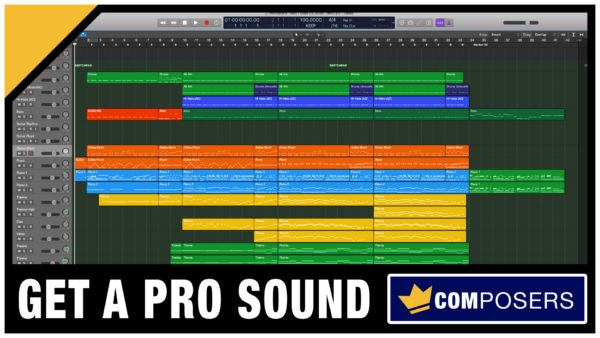 So you want to make your music sound better? You want a crystal clear sound, with shimmering highs, focused mids and powerful lows, right? =)
So you want to make your music sound better? You want a crystal clear sound, with shimmering highs, focused mids and powerful lows, right? =)
The answer does not lie in the production and mixing, but the very composing stage.
And the main solution is to make sure that no section of your composition is too cluttered.
Hello Composers! 😃
– Mike here, and I am going to share my top guidelines on how to get a professional sounding music composition. Oh, and these guidelines are very powerful, because you apply them before the mixing stage of your music production.
1. Everything in its Place
Creating a focused music composition with a high degree of clarity and separation, is almost like organising your kitchen.
If you carefully structure all drawers and cabinets so that you can easily find and access everything you need, you will have a much more efficient kitchen, right?
Well, have you ever seen the strict order a master chef has in his kitchen? Everything in its place. And they prepare everything before they even start to cook.
The secret to getting a great overall sound in your music is basically like having the mindset of a master chef. Everything in its place.
2. The Note Distribution in the Octaves
Always keeping an eye on the MIDI notes for all parts is one of the best ways to make sure you don’t clutter any octave with too many different parts.
You simply select all parts of any section in your track and look at how the notes are distributed in the piano roll editor.
If you find clutter in any section and range. Consider either removing a part that “clouds” another, or transposing a part up or down.
3. The Frequency Centre of Sounds
Sometimes you don’t have MIDI available, for example when you recorded guitars or vocals. Well, that’s when you bring out a frequency analyzer for that track, which is something almost all DAWs has.
Then you look at the analyzer to see the main focal centre of the part. That is one way. But what I find even better, is to select for example a piano track in your DAW, then as you listen to for example the vocal part…pick out the melody on the piano.
The point is to find a note that you feel is the pitch centre of that specific part. If you want to be really clear, you can even write in that centre pitch in the naming of the audio part in your sequencer.
Always have a clear overview of the distribution of notes and frequencies in your composition.
4. The Colors of Music
Another way which I have started using, is to color all parts in my track according to their role in the composition.
For example, the bass parts are red, the melodic drive parts are orange, the backing parts like chords and comping are blue, and the main theme, harmony lines and counterpoint are different shades of yellow.
This way you will clearly see when you get too much of any one color in a section. This will be like a warning sign…but remember…sometimes you can have lots of tracks even with the same role in the track, but then most of them will do the same thing. Meaning layers of unison or octaves.
For example, let’s say you have a chord progression where the first chord is a simple A minor. That is 3 notes: A, C and E.
Then you might have 3 different instruments playing the A, another 3 playing the C, another another 3 playing the E note. 9 instruments instead of a piano or a single string ensemble patch, but you would still not clutter the composition, because it would still be the same A minor chord.
Another point is that with very short sounds, you can get away with more going on at the same time. Like drums and percussion or very short staccato notes.
But again, the main point here is to use colors to help yourself when you compose your track. You want to develop your own system of coloring all your parts to represent their main role in the track.
Summary: Compose Music that Sound Professional
- Everything in its Place
You need to plan your composition, and have a structure and order for every part. Everything needs to have its own dedicated place in your music. - The Note Distribution in the Octaves
Always keep an eye on the MIDI notes for all parts and how they are distributed over the octaves. - The Frequency Centre of Sounds
Analyze the audio recordings you add like vocals, guitars, sound effects etc. You want to find out what their frequency centre is, a specific note. That will give you a good understanding its place in the composition. - The Colors of Music
I like to use colors of parts in my DAW, not to divide parts per instrument like many composers do, but to clarify every parts role in the composition.
How to Compose Crystal Clear Music?
Well, these guidelines have helped me get much more professional and clear sounding compositions.
Because composing music, is like creating a story. And a story needs a clear direction and storyline to keep the audience engaged. Always start with your music story, your composition.
Then you polish it in the production stage with mixing and mastering. It’s like a great movie. You need to start with a great story first. Like a great novel, or amazing script. Your story always comes first. =)
